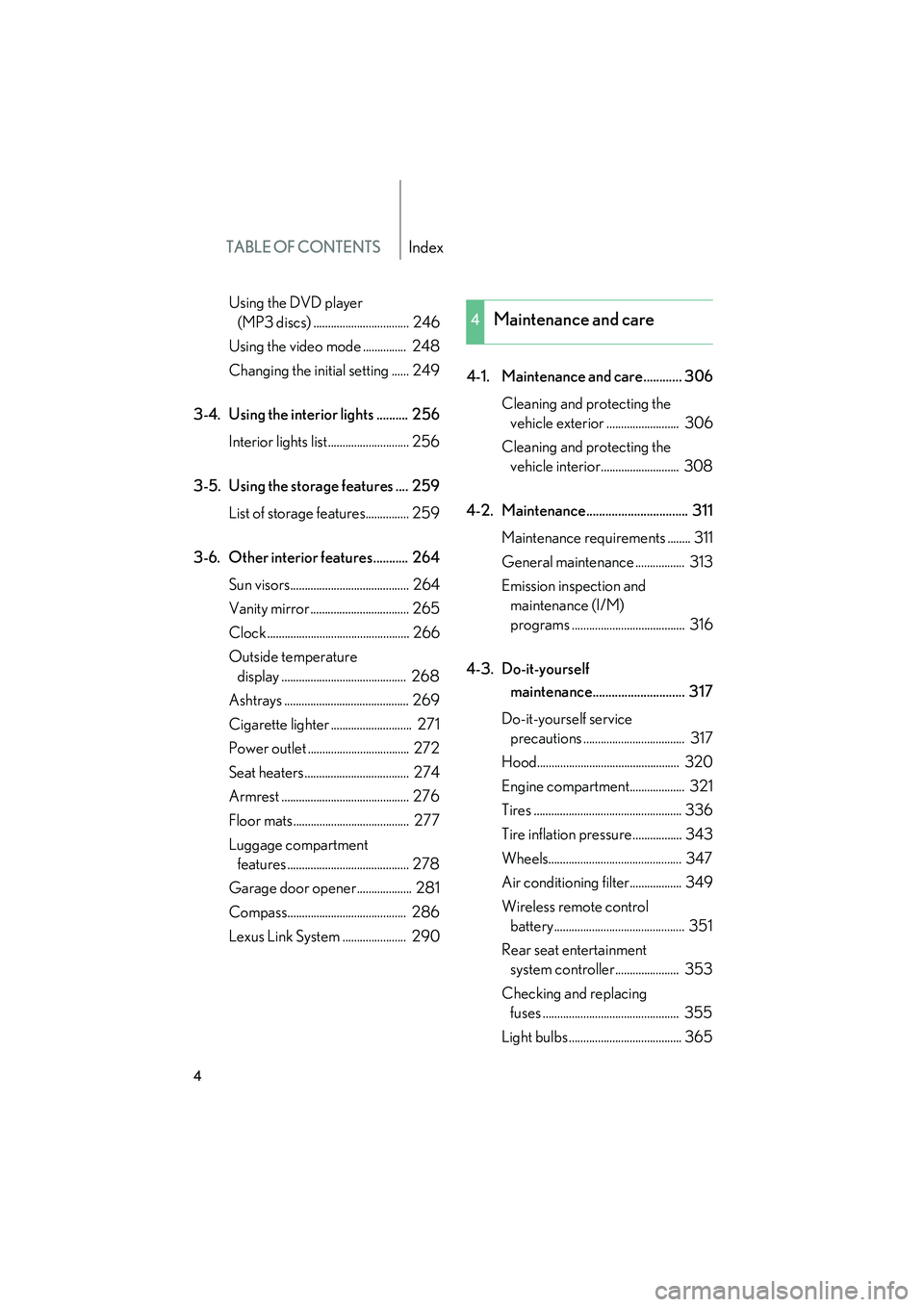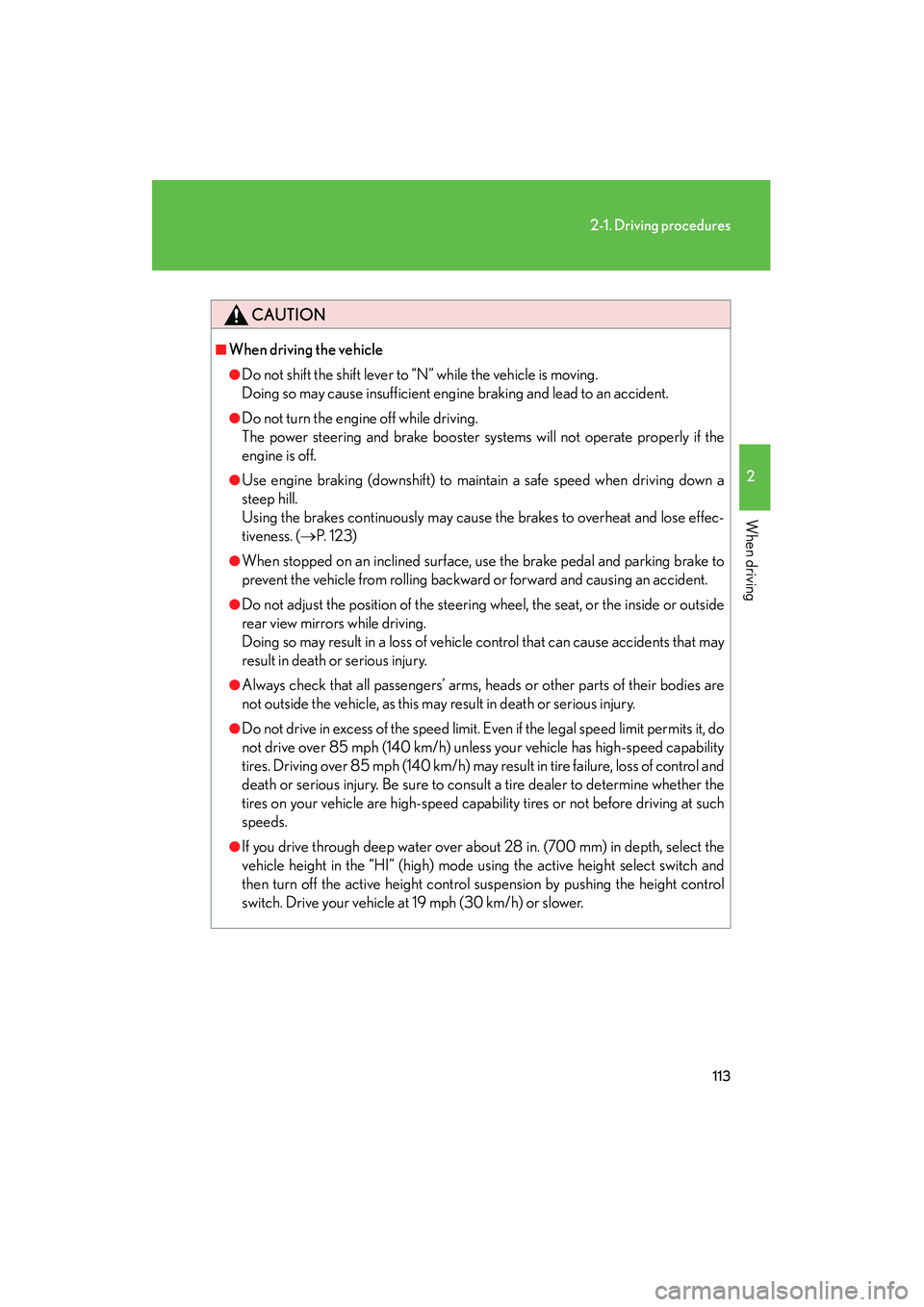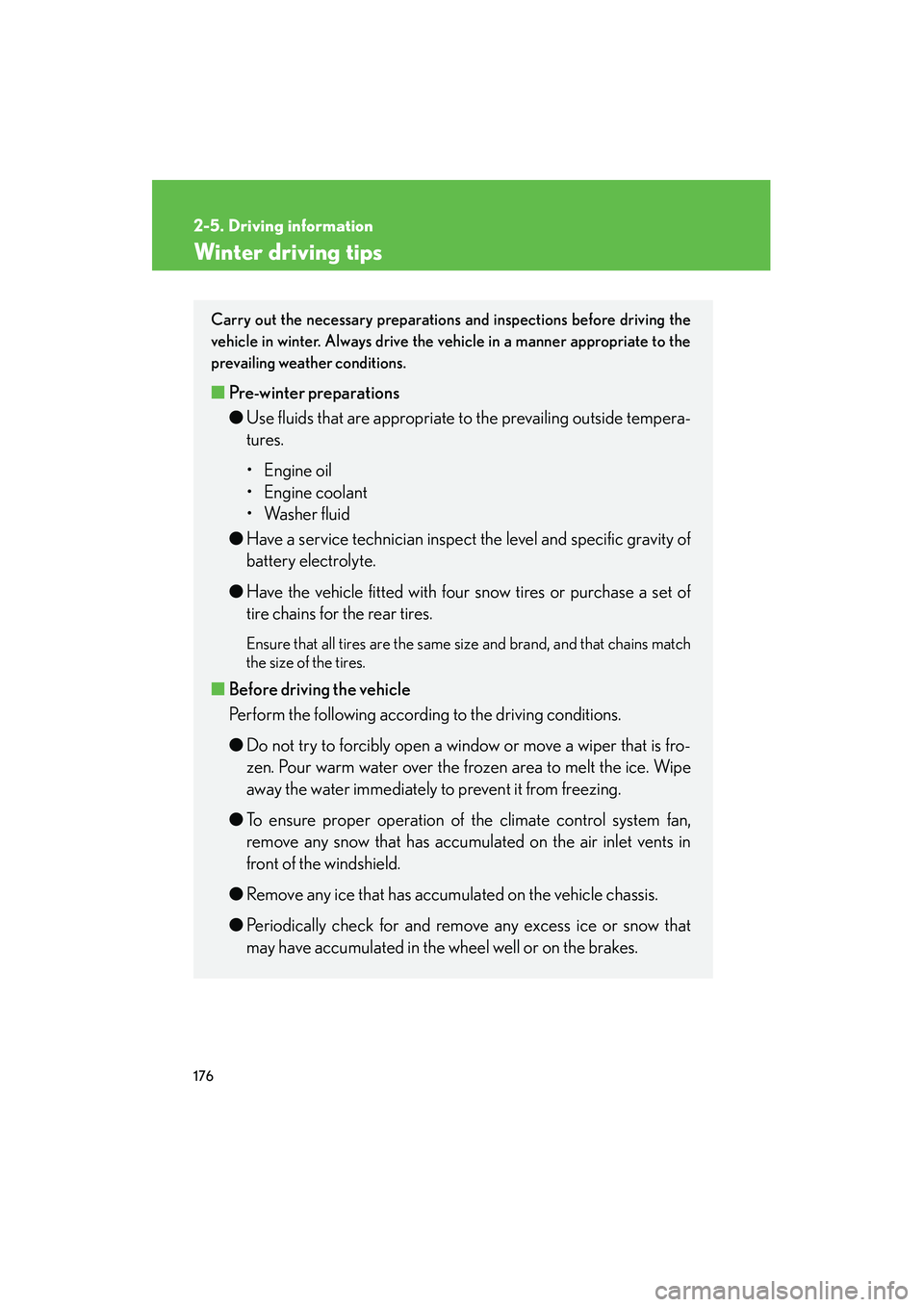Page 5 of 458

TABLE OF CONTENTSIndex
4
Using the DVD player (MP3 discs) ................................. 246
Using the video mode ............... 248
Changing the initial setting ...... 249
3-4. Using the interior lights .......... 256 Interior lights list............................ 256
3-5. Using the storage features .... 259 List of storage features............... 259
3-6. Other interior features........... 264 Sun visors......................................... 264
Vanity mirror .................................. 265
Clock ................................................. 266
Outside temperature display ........................................... 268
Ashtrays ........................................... 269
Cigarette lighter ............................ 271
Power outlet ................................... 272
Seat heaters.................................... 274
Armrest ............................................ 276
Floor mats........................................ 277
Luggage compartment features .......................................... 278
Garage door opener................... 281
Compass......................................... 286
Lexus Link System ...................... 290 4-1. Maintenance and care............ 306
Cleaning and protecting the vehicle exterior ......................... 306
Cleaning and protecting the vehicle interior........................... 308
4-2. Maintenance................................ 311 Maintenance requirements ........ 311
General maintenance ................. 313
Emission inspection and maintenance (I/M)
programs ....................................... 316
4-3. Do-it-yourself maintenance............................. 317
Do-it-yourself service precautions ................................... 317
Hood................................................. 320
Engine compartment................... 321
Tires ................................................... 336
Tire inflation pressure................. 343
Wheels.............................................. 347
Air conditioning filter.................. 349
Wireless remote control battery............................................. 351
Rear seat entertainment system controller...................... 353
Checking and replacing fuses ............................................... 355
Light bulbs ....................................... 365
4Maintenance and care
Page 112 of 458

111
2-1. Driving procedures
2
When driving
■Driving in the rain
●Drive carefully when it is raining, because visibility will be reduced, the windows
may become fogged-up, and the road will be slippery.
●Drive carefully when it starts to rain, because the road surface will be especially
slippery.
●Refrain from high speeds when driving on an expressway in the rain, because
there may be a layer of water between the tires and the road surface, preventing
the steering and brakes from operating properly.
■Breaking in your new Lexus
To extend the life of the vehicle, the following precautions are recommended to
observe:
●For the first 200 miles (300 km):
Avoid sudden stops.
●For the first 500 miles (800 km):
Do not tow a trailer.
●For the first 600 miles (1000 km):
• Do not drive at extremely high speeds.
• Avoid sudden acceleration.
• Do not drive continuously in the low gears.
• Do not drive at a constant speed for extended periods.
■Operating your vehicle in a foreign country
Comply with the relevant vehicle registration laws and confirm the availability of the
correct fuel. (→P. 414)
Page 114 of 458

113
2-1. Driving procedures
2
When driving
CAUTION
■When driving the vehicle
●Do not shift the shift lever to “N” while the vehicle is moving.
Doing so may cause insufficient engine braking and lead to an accident.
●Do not turn the engine off while driving.
The power steering and brake booster systems will not operate properly if the
engine is off.
●Use engine braking (downshift) to maintain a safe speed when driving down a
steep hill.
Using the brakes continuously may cause the brakes to overheat and lose effec-
tiveness. ( →P. 1 2 3 )
●When stopped on an inclined surface, use the brake pedal and parking brake to
prevent the vehicle from rolling backward or forward and causing an accident.
●Do not adjust the position of the steering wheel, the seat, or the inside or outside
rear view mirrors while driving.
Doing so may result in a loss of vehicle control that can cause accidents that may
result in death or serious injury.
●Always check that all passengers’ arms, heads or other parts of their bodies are
not outside the vehicle, as this may result in death or serious injury.
●Do not drive in excess of the speed limit. Even if the legal speed limit permits it, do
not drive over 85 mph (140 km/h) unless your vehicle has high-speed capability
tires. Driving over 85 mph (140 km/h) may result in tire failure, loss of control and
death or serious injury. Be sure to consult a tire dealer to determine whether the
tires on your vehicle are high-speed capability tires or not before driving at such
speeds.
●If you drive through deep water over about 28 in. (700 mm) in depth, select the
vehicle height in the “HI” (high) mode using the active height select switch and
then turn off the active height control suspension by pushing the height control
switch. Drive your vehicle at 19 mph (30 km/h) or slower.
Page 160 of 458

159
2-4. Using other driving systems
2
When driving
Driving assist systems
To help enhance driving safety and performance, the following systems
operate automatically in response to various driving situations. Be aware,
however, that these systems are supplementary and should not be relied
upon too heavily when operating the vehicle.
■ ABS (Anti-lock Brake System)
Helps to prevent wheel lock when the brakes are applied suddenly, or if
the brakes are applied while driving on a slippery road surface.
■Brake Assist
Generates an increased level of braking force after the brake pedal is
depressed, when the system detects a panic stop situation.
■VSC (Vehicle Stability Control)
Helps the driver to control skidding when swerving suddenly or turning on
slippery road surfaces.
■Active traction control
Maintains drive power and prevents the 4 wheels from spinning when
starting the vehicle or accelerating on slippery roads.
■Hill-start assist control
Helps prevent the vehicle from rolling backwards when starting on an
incline or slippery slope. It operates for approximately 5 seconds at maxi-
mum.
■Limited Slip Differential
Transfers drive power to the rear tires when front tires spin, and vice versa,
in order to improve traction.
■Kinetic Dynamic Suspension System (if equipped)
Kinetic Dynamic Suspension System helps to significantly enhance han-
dling response by reducing roll stiffness of the suspension stabilizer bars
through means of a hydraulic control system.
Page 163 of 458
162
2-4. Using other driving systems
CAUTION
■Replacing tires
Make sure that all tires are of the same size, brand, tread pattern and total load
capacity. In addition, make sure that the tires are inflated to the specified tire pres-
sure level.
The ABS and VSC will not function correctly if different tires are fitted on the vehi-
cle.
Contact your Lexus dealer for further information when replacing tires or wheels.
■Handling of tires and suspension
Using tires with any kind of problem or modifying the suspension will affect the driv-
ing assist systems, and may cause the system to malfunction.
Page 176 of 458
175
2-5. Driving information
2
When driving
■Total load capacity and seating capacity
These details are also described on the tire and loading information label.
(→ P. 3 4 3 )
CAUTION
■Overloading the vehicle
Do not overload the vehicle.
It may not only cause damage to the tires, but also degrade steering and braking
ability, resulting in an accident.
Page 177 of 458

176
2-5. Driving information
Winter driving tips
Carry out the necessary preparations and inspections before driving the
vehicle in winter. Always drive the vehicle in a manner appropriate to the
prevailing weather conditions.
■Pre-winter preparations
●Use fluids that are appropriate to the prevailing outside tempera-
tures.
• Engine oil
• Engine coolant
• Washer fluid
● Have a service technician inspect the level and specific gravity of
battery electrolyte.
● Have the vehicle fitted with four snow tires or purchase a set of
tire chains for the rear tires.
Ensure that all tires are the same size and brand, and that chains match
the size of the tires.
■ Before driving the vehicle
Perform the following according to the driving conditions.
●Do not try to forcibly open a window or move a wiper that is fro-
zen. Pour warm water over the frozen area to melt the ice. Wipe
away the water immediately to prevent it from freezing.
● To ensure proper operation of the climate control system fan,
remove any snow that has accumulated on the air inlet vents in
front of the windshield.
● Remove any ice that has accumulated on the vehicle chassis.
● Periodically check for and remove any excess ice or snow that
may have accumulated in the wheel well or on the brakes.
Page 178 of 458
177
2-5. Driving information
2
When drivingSelecting snow chains
Use the correct snow chain size when mounting the snow chains. Chain size
is regulated for each tire sizes. Side chain:0.20 in. (5.0 mm)
1.81 in. (46.0 mm)
0.71 in. (18.0 mm)
Cross chain: 0.25 in. (6.3 mm)
1.5 in. (38.1 mm)
0.89 in. (22.6 mm)
Regulations on the use of snow chains
● Regulations regarding the use of tire chains vary according to location
and type of road. Always check local regulations before installing
chains.
● Install the chains on the rear tires.
● Retighten the chains after driving 1 /4 - 1 /2 mile (0.5 - 1.0 km).
■When driving the vehicle
Accelerate the vehicle slowly and drive at a reduced speed suitable
to road conditions.
■ When parking the vehicle
Park the vehicle and move the shift lever to “P” without setting the
parking brake. The parking brake may freeze, preventing it from
being released.